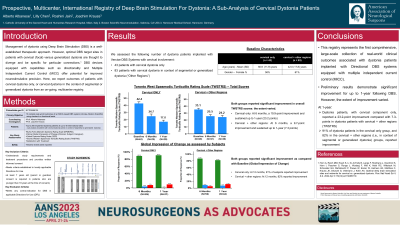Prospective, Multicenter, International Registry of Deep Brain Stimulation for Dystonia: A Sub-Analysis of Cervical Dystonia Patients
Prospective, Multicenter, International Registry of Deep Brain Stimulation for Dystonia: A Sub-analysis of Cervical Dystonia Patients
Friday, April 21, 2023


Alberto Albanese, MD
Professor of Neurology
Universita Cattolica Sacra Cuore
ePoster Presenter(s)
Introduction: Management of dystonia using Deep Brain Stimulation (DBS) is a well-established therapeutic approach. However, optimal DBS target sites in patients with cervical (focal) versus generalized dystonia are thought to diverge and be specific for particular connections (Horn 2022). DBS devices equipped with capabilities such as directionality and Multiple Independent Current Control (MICC) may offer potential for improved clinical outcomes. Here, we report a sub-analysis of patients with cervical dystonia only or dystonia with cervical involvement from an on-going, multicenter registry.
Methods: In this prospective, on-label, multi-center, international registry (ClinicalTrials.gov Identifier: NCT02686125) of dystonia, enrolled subjects received MICC-based directional DBS systems (Vercise, Boston Scientific). Subjects were followed up to 3-years (post-implant). Several study assessments evaluating their dystonia symptoms (e.g., TWSTRS), quality of life (GIC) and overall satisfaction were administered. Adverse Events were also collected.
Results: A total of 43-patients (mean age 56.9-years, 58% females) with focal (cervical) dystonia only and 83-patients (mean 41.95-years, 61% females) with generalized or segmental dystonia with cervical involvement who underwent pallidal DBS were prospectively evaluated. Both groups reported significant improvement in overall TWSTRS scores – however the extent varied. In the cervical only cohort, a 19.9-point improvement was noted at 6-months (n=25) and sustained up to 1-year (23.2-point improvement, n=20). In those with generalized or segmental dystonia (with cervical involvement), a 9.7-point. and 7.3-improvement in overall TWSTRS scores was noted at 6- (n = 50) and 12-months (n = 38), respectively.
Conclusion : This registry represents the first comprehensive, large-scale collection of real-world outcomes associated with dystonia patients implanted with a directional DBS system capable of MICC. Preliminary results demonstrate significant improvement in patients with cervical dystonia (either alone or with other regions involved) following DBS.
Methods: In this prospective, on-label, multi-center, international registry (ClinicalTrials.gov Identifier: NCT02686125) of dystonia, enrolled subjects received MICC-based directional DBS systems (Vercise, Boston Scientific). Subjects were followed up to 3-years (post-implant). Several study assessments evaluating their dystonia symptoms (e.g., TWSTRS), quality of life (GIC) and overall satisfaction were administered. Adverse Events were also collected.
Results: A total of 43-patients (mean age 56.9-years, 58% females) with focal (cervical) dystonia only and 83-patients (mean 41.95-years, 61% females) with generalized or segmental dystonia with cervical involvement who underwent pallidal DBS were prospectively evaluated. Both groups reported significant improvement in overall TWSTRS scores – however the extent varied. In the cervical only cohort, a 19.9-point improvement was noted at 6-months (n=25) and sustained up to 1-year (23.2-point improvement, n=20). In those with generalized or segmental dystonia (with cervical involvement), a 9.7-point. and 7.3-improvement in overall TWSTRS scores was noted at 6- (n = 50) and 12-months (n = 38), respectively.
Conclusion : This registry represents the first comprehensive, large-scale collection of real-world outcomes associated with dystonia patients implanted with a directional DBS system capable of MICC. Preliminary results demonstrate significant improvement in patients with cervical dystonia (either alone or with other regions involved) following DBS.
